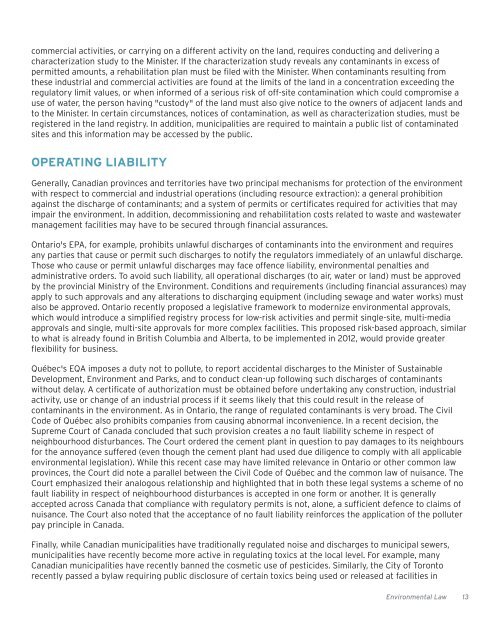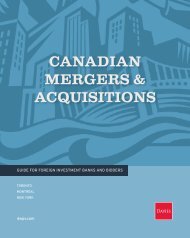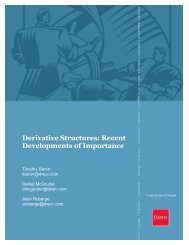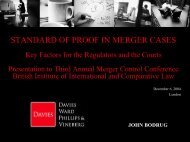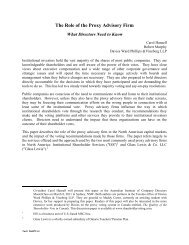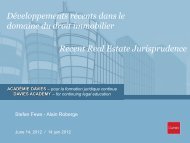ENVIRONMENTAL LAWLEGAL FRAMEWORKIn Canada, environmental matters are regulated at the federal, prov<strong>in</strong>cial, territorial and local levels. Althoughprov<strong>in</strong>cial and territorial governments generally take the lead <strong>in</strong> regulat<strong>in</strong>g most environmental matters, <strong>in</strong>recent years the federal and municipal governments have become more active <strong>in</strong> environmental protection.Harmonization of programs and standards has taken place <strong>in</strong> Canada, but <strong>in</strong> most circumstances, separatefederal, prov<strong>in</strong>cial, territorial and municipal requirements apply. In particular, each prov<strong>in</strong>ce and territory <strong>in</strong>Canada has its own unique environmental impact assessment and protection regimes.CONTAMINATED PROPERTYThe contam<strong>in</strong>ation of soil and groundwater is primarily regulated by the prov<strong>in</strong>ces and territories. Although theSupreme Court of Canada has confirmed the operation of the statutory "polluter pay" pr<strong>in</strong>ciple, purchasers ofreal property must be aware that they may be held liable for pre-exist<strong>in</strong>g contam<strong>in</strong>ation on and migrat<strong>in</strong>g fromnewly acquired property. Tenants should ensure that leases provide protection from such liability.For example, <strong>in</strong> Ontario, the Environmental Protection Act (the "EPA") provides for adm<strong>in</strong>istrative orders to beissued aga<strong>in</strong>st anyone who owns or has management or control of a contam<strong>in</strong>ated property, whether or not thatperson or entity caused the contam<strong>in</strong>ation. Where the discharge of a contam<strong>in</strong>ant cont<strong>in</strong>ues after a sale ortenancy, the new owner or tenant may also be viewed as hav<strong>in</strong>g permitted the discharge to take place even if itdid not cause the source of contam<strong>in</strong>ation. Such owners and tenants may be subject to remediation liability, butthere is generally no positive statutory obligation <strong>in</strong> Ontario to clean up historic contam<strong>in</strong>ation.The EPA provides some limited protection from statutory liability. If appropriate <strong>in</strong>vestigations and remedialwork are conducted and a record of site condition ("RSC") is filed, an owner or tenant is protected fromregulatory action with respect to contam<strong>in</strong>ants identified <strong>in</strong> the RSC (except <strong>in</strong> certa<strong>in</strong> circumstances wherecontam<strong>in</strong>ation migrates from the site or the regulator believes there is a danger to health or safety). It is alsoobligatory to file a RSC when a change to a more sensitive property use is planned.As <strong>in</strong> Ontario, Québec's Environment Quality Act (the "EQA") subjects the polluter and also on any person thathas or had "custody" s<strong>in</strong>ce March 2003 of a contam<strong>in</strong>ated site (e.g., as owner, tenant or occupant), even if suchentity did not cause the contam<strong>in</strong>ation, to clean-up obligations upon the issuance of an order from the M<strong>in</strong>isterof Susta<strong>in</strong>able Development, Environment and Parks. A secured creditor that takes possession of acontam<strong>in</strong>ated site might also be deemed to have "custody" of the site and be liable for its clean-up.In many <strong>in</strong>stances, decontam<strong>in</strong>ation <strong>in</strong> Québec must be undertaken under the monitor<strong>in</strong>g of the M<strong>in</strong>ister ofSusta<strong>in</strong>able Development, Environment and Parks, through the use of rehabilitation plans and implementationschedules, which must be approved by the M<strong>in</strong>ister and may provide for land use restrictions. A description ofthe works required under the rehabilitation plan and a statement of the land use restrictions, <strong>in</strong>clud<strong>in</strong>g theresult<strong>in</strong>g charges and obligations, must be registered <strong>in</strong> the land registry. This registration renders therehabilitation plan b<strong>in</strong>d<strong>in</strong>g on third parties and any subsequent acquirer of the land is bound by the charges andobligations provided for <strong>in</strong> the rehabilitation plan (<strong>in</strong>clud<strong>in</strong>g land use restrictions).While rehabilitation required pursuant to an order by the M<strong>in</strong>ister of Susta<strong>in</strong>able Development, Environment andParks, must be conducted <strong>in</strong> accordance with the EQA procedures, no positive statutory duty to decontam<strong>in</strong>ate acontam<strong>in</strong>ated site currently exists <strong>in</strong> Québec. However, ceas<strong>in</strong>g to carry on certa<strong>in</strong> specified <strong>in</strong>dustrial and12 Environmental Law
commercial activities, or carry<strong>in</strong>g on a different activity on the land, requires conduct<strong>in</strong>g and deliver<strong>in</strong>g acharacterization study to the M<strong>in</strong>ister. If the characterization study reveals any contam<strong>in</strong>ants <strong>in</strong> excess ofpermitted amounts, a rehabilitation plan must be filed with the M<strong>in</strong>ister. When contam<strong>in</strong>ants result<strong>in</strong>g fromthese <strong>in</strong>dustrial and commercial activities are found at the limits of the land <strong>in</strong> a concentration exceed<strong>in</strong>g theregulatory limit values, or when <strong>in</strong>formed of a serious risk of off-site contam<strong>in</strong>ation which could compromise ause of water, the person hav<strong>in</strong>g "custody" of the land must also give notice to the owners of adjacent lands andto the M<strong>in</strong>ister. In certa<strong>in</strong> circumstances, notices of contam<strong>in</strong>ation, as well as characterization studies, must beregistered <strong>in</strong> the land registry. In addition, municipalities are required to ma<strong>in</strong>ta<strong>in</strong> a public list of contam<strong>in</strong>atedsites and this <strong>in</strong>formation may be accessed by the public.OPERATING LIABILITYGenerally, Canadian prov<strong>in</strong>ces and territories have two pr<strong>in</strong>cipal mechanisms for protection of the environmentwith respect to commercial and <strong>in</strong>dustrial operations (<strong>in</strong>clud<strong>in</strong>g resource extraction): a general prohibitionaga<strong>in</strong>st the discharge of contam<strong>in</strong>ants; and a system of permits or certificates required for activities that mayimpair the environment. In addition, decommission<strong>in</strong>g and rehabilitation costs related to waste and wastewatermanagement facilities may have to be secured through f<strong>in</strong>ancial assurances.Ontario's EPA, for example, prohibits unlawful discharges of contam<strong>in</strong>ants <strong>in</strong>to the environment and requiresany parties that cause or permit such discharges to notify the regulators immediately of an unlawful discharge.Those who cause or permit unlawful discharges may face offence liability, environmental penalties andadm<strong>in</strong>istrative orders. To avoid such liability, all operational discharges (to air, water or land) must be approvedby the prov<strong>in</strong>cial M<strong>in</strong>istry of the Environment. Conditions and requirements (<strong>in</strong>clud<strong>in</strong>g f<strong>in</strong>ancial assurances) mayapply to such approvals and any alterations to discharg<strong>in</strong>g equipment (<strong>in</strong>clud<strong>in</strong>g sewage and water works) mustalso be approved. Ontario recently proposed a legislative framework to modernize environmental approvals,which would <strong>in</strong>troduce a simplified registry process for low-risk activities and permit s<strong>in</strong>gle-site, multi-mediaapprovals and s<strong>in</strong>gle, multi-site approvals for more complex facilities. This proposed risk-based approach, similarto what is already found <strong>in</strong> British Columbia and Alberta, to be implemented <strong>in</strong> 2012, would provide greaterflexibility for <strong>bus<strong>in</strong>ess</strong>.Québec's EQA imposes a duty not to pollute, to report accidental discharges to the M<strong>in</strong>ister of Susta<strong>in</strong>ableDevelopment, Environment and Parks, and to conduct clean-up follow<strong>in</strong>g such discharges of contam<strong>in</strong>antswithout delay. A certificate of authorization must be obta<strong>in</strong>ed before undertak<strong>in</strong>g any construction, <strong>in</strong>dustrialactivity, use or change of an <strong>in</strong>dustrial process if it seems likely that this could result <strong>in</strong> the release ofcontam<strong>in</strong>ants <strong>in</strong> the environment. As <strong>in</strong> Ontario, the range of regulated contam<strong>in</strong>ants is very broad. The CivilCode of Québec also prohibits companies from caus<strong>in</strong>g abnormal <strong>in</strong>convenience. In a recent decision, theSupreme Court of Canada concluded that such provision creates a no fault liability scheme <strong>in</strong> respect ofneighbourhood disturbances. The Court ordered the cement plant <strong>in</strong> question to pay damages to its neighboursfor the annoyance suffered (even though the cement plant had used due diligence to comply with all applicableenvironmental legislation). While this recent case may have limited relevance <strong>in</strong> Ontario or other common lawprov<strong>in</strong>ces, the Court did note a parallel between the Civil Code of Québec and the common law of nuisance. TheCourt emphasized their analogous relationship and highlighted that <strong>in</strong> both these legal systems a scheme of nofault liability <strong>in</strong> respect of neighbourhood disturbances is accepted <strong>in</strong> one form or another. It is generallyaccepted across Canada that compliance with regulatory permits is not, alone, a sufficient defence to claims ofnuisance. The Court also noted that the acceptance of no fault liability re<strong>in</strong>forces the application of the polluterpay pr<strong>in</strong>ciple <strong>in</strong> Canada.F<strong>in</strong>ally, while Canadian municipalities have traditionally regulated noise and discharges to municipal sewers,municipalities have recently become more active <strong>in</strong> regulat<strong>in</strong>g toxics at the local level. For example, manyCanadian municipalities have recently banned the cosmetic use of pesticides. Similarly, the City of Torontorecently passed a bylaw requir<strong>in</strong>g public disclosure of certa<strong>in</strong> toxics be<strong>in</strong>g used or released at facilities <strong>in</strong>Environmental Law 13
- Page 1 and 2: DOING BUSINESSIN CANADAYOUR COMPLET
- Page 3 and 4: ONTENTSTABLE OF CONTENTSINTRODUCTIO
- Page 5 and 6: IntroductionPOLITICAL AND CONSTITUT
- Page 7 and 8: 5RealEstateIndustrial and Intellect
- Page 9 and 10: accordance with directions from the
- Page 11 and 12: TITLE INSURANCE, TITLE OPINIONS AND
- Page 13: 11EnvironmentalLawIndustrial and In
- Page 17 and 18: The federal government currently re
- Page 19 and 20: 17Types ofBusiness OrganizationIndu
- Page 21 and 22: provincial law cannot do so as of r
- Page 23 and 24: partnership, limited partners’ li
- Page 25 and 26: parties. In Québec, joint venturer
- Page 27 and 28: 25Financing aBusiness OperationIndu
- Page 29 and 30: The Civil Code of Québec provides
- Page 31 and 32: 29CorporateGovernanceIndustrial and
- Page 33 and 34: Instrument 58-101. The practices re
- Page 35 and 36: 33CompetitionLawIndustrial and Inte
- Page 37 and 38: BID-RIGGINGBid rigging is any agree
- Page 39 and 40: anticompetitive agreements among co
- Page 41 and 42: 39ForeignInvestmentIndustrial and I
- Page 43 and 44: apply for Canadian citizenship. (Pe
- Page 45 and 46: (D)GENERAL REVIEW THRESHOLDSThe fol
- Page 47 and 48: there be an "acquisition of control
- Page 49 and 50: Industrial and Intellectual Propert
- Page 51 and 52: to perform or cause them to be perf
- Page 53 and 54: Registration grants an exclusive ri
- Page 55 and 56: PIPEDA applies in all provinces of
- Page 57 and 58: Employment LawCanadian employment l
- Page 59 and 60: displacement, laying-off, suspensio
- Page 61 and 62: easonable cause to believe that the
- Page 63 and 64: 63Retirement Plans, EmployeeBenefit
- Page 65 and 66:
• funding;• eligibility;• pen
- Page 67 and 68:
67Temporary Entry andPermanent Resi
- Page 69 and 70:
INTERNATIONAL AGREEMENTSIn recent y
- Page 71 and 72:
immigrant in another class, he or s
- Page 73 and 74:
73Bankruptcy andInsolvency Proceedi
- Page 75 and 76:
BANKRUPTCYBankruptcy results in the
- Page 77 and 78:
INTERNATIONAL BANKRUPTCYASSETS LOCA
- Page 79 and 80:
Tax ConsiderationsThis chapter prov
- Page 81 and 82:
TAX REPORTINGAnnual Tax ReturnsCana
- Page 83 and 84:
Québec has legislation that limits
- Page 85 and 86:
Amendments, SIFTs and their unithol
- Page 87 and 88:
Conversely, where a Canadian reside
- Page 89 and 90:
A person, whether resident in Canad
- Page 91 and 92:
APPENDIX I: CANADA’S IN FORCE TAX
- Page 93:
TORONTODAVIES WARD PHILLIPS & VINEB


